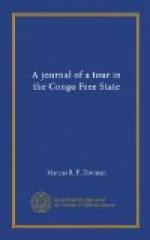This is evidently one of the most populous districts in the whole Congo, for on all sides, both at the river edge and on the hill tops, are large villages consisting of tent-shaped huts and shimbeks, or square open sheds, under which the natives sit and sleep most of the day. Besides rubber, great quantities of rice are grown here, the plantations extending parallel to the river for more than two miles. Here men, women, and children are at work and those near the road come forward, give a military salute and shake hands, a custom peculiar to this part, for hitherto the women have not saluted and only the chiefs offered the hand. Many of the people have thin lips and Semitic noses and most are well made. As usual, if one meets a husband and wife, the former strolls ahead with a spear or stick, while the latter follows carrying a baby riding on one of her hips, tied on by her wrap of cloth, and with a heavy load of wood or food-stuff on her head. We cross the river in the evening and dine with Captain Meilleur at Mobaie. The French villages are identical with those on the State side, but the natives are, if possible, still more idle.
Next morning much rubber is brought into Banzyville. Strings of natives, each with a little basket-full of this substance, march into the square and sit down in lines on the gravel. The baskets are then weighed on a yard arm and the weights entered in a book by Captain Auita until a record of the whole has been made when the chattering throng departs to a shed near by where five cooks have been hard at work preparing dinner for them. The natives here are paid in cloth at the rate of 50 or 60 centimes a kilogramme according to the quality of the rubber and although each man is supposed to supply only one kilogramme a month some of the villages here send in more than a ton in that time.
Mr. Fernaka, the second in command, arrived on the 28th after marching for thirty days in the interior over unexplored ground. He said it was mostly marsh land containing a few villages from which the inhabitants, seeing the white man approach with his soldiers, fled into the bush. At first indeed the natives are always fearful of the whites, but in a short time are willing to trade and soon become very friendly. The native, in fact, quickly acquires absolute confidence in Europeans and his fear at first is, obviously, only the fear of the unknown. It is rather amusing to see the children in villages where few white men have penetrated, run shrieking with terror to their mothers when a strange looking person, with a white face and clothes appears. At the sound of the launch whistle also many children run away. One of the soldiers, a sergeant of some years’ standing who accompanied Mr. Fernaka on his arduous march, unfortunately contracted dysentery and arrived at Banzyville only to die. We attend the funeral, the absolute simplicity of the ceremony being very impressive. All the troops here, perhaps




